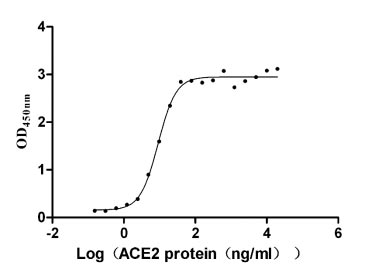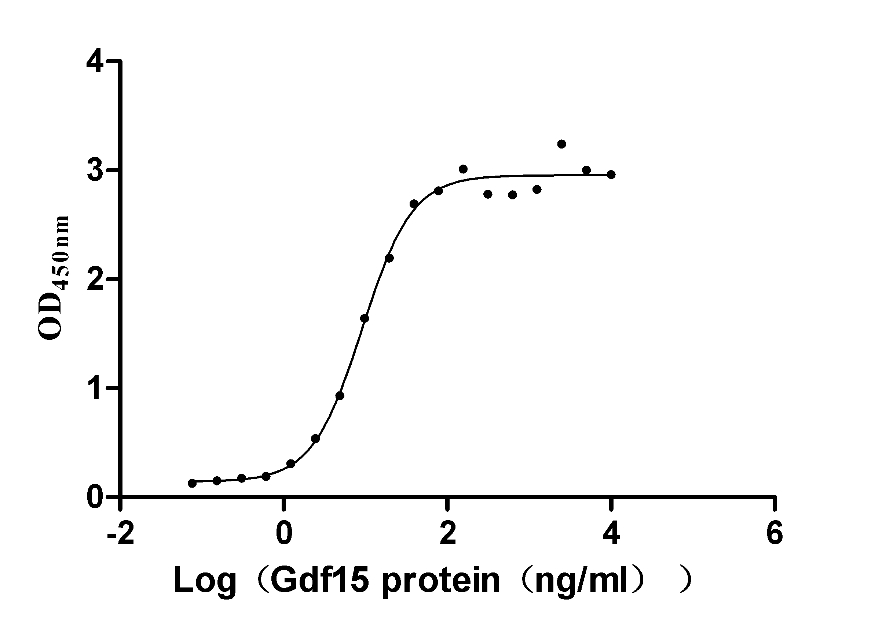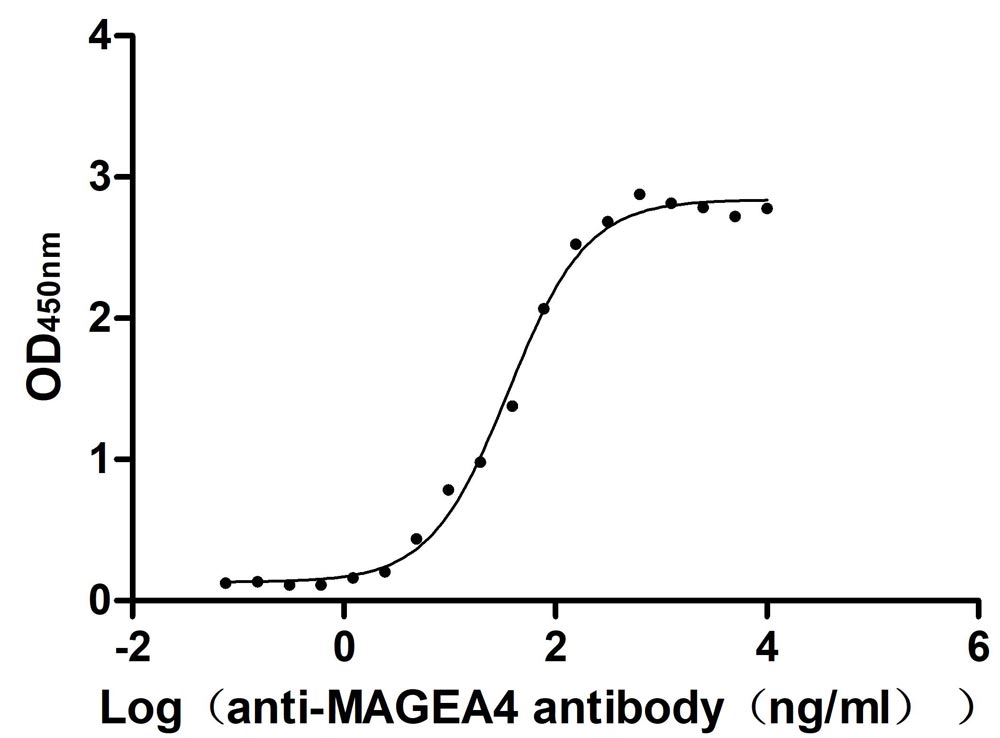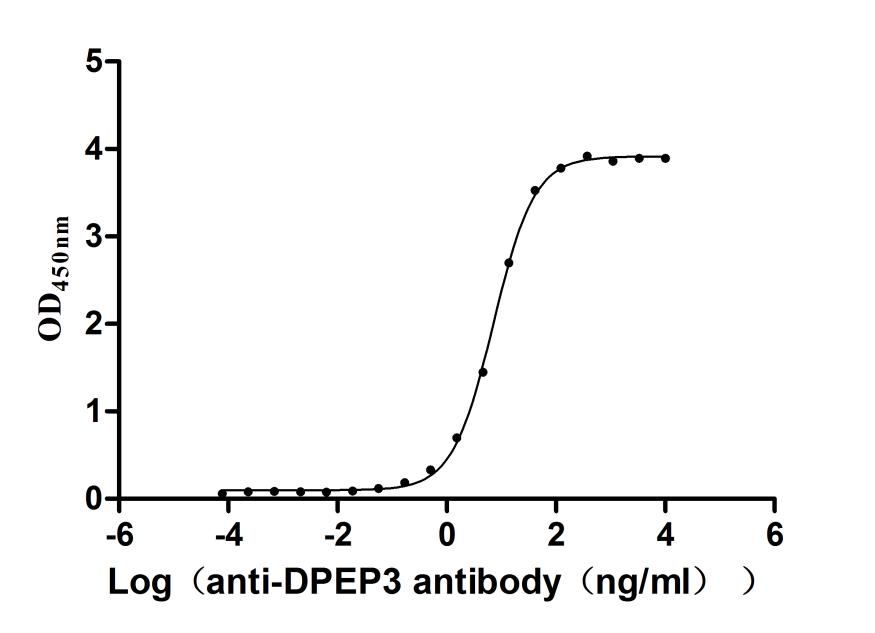Recombinant Rat Guanine nucleotide-binding protein G (i) subunit alpha-1 (Gnai1)
-
货号:CSB-YP009588RA
-
规格:
-
来源:Yeast
-
其他:
-
货号:CSB-EP009588RA
-
规格:
-
来源:E.coli
-
其他:
-
货号:CSB-EP009588RA-B
-
规格:
-
来源:E.coli
-
共轭:Avi-tag Biotinylated
E. coli biotin ligase (BirA) is highly specific in covalently attaching biotin to the 15 amino acid AviTag peptide. This recombinant protein was biotinylated in vivo by AviTag-BirA technology, which method is BriA catalyzes amide linkage between the biotin and the specific lysine of the AviTag.
-
其他:
-
货号:CSB-BP009588RA
-
规格:
-
来源:Baculovirus
-
其他:
-
货号:CSB-MP009588RA
-
规格:
-
来源:Mammalian cell
-
其他:
产品详情
-
纯度:>85% (SDS-PAGE)
-
基因名:
-
Uniprot No.:
-
别名:Gnai1; Gnai-1Guanine nucleotide-binding protein G(i) subunit alpha-1; Adenylate cyclase-inhibiting G alpha protein
-
种属:Rattus norvegicus (Rat)
-
蛋白长度:Full Length of Mature Protein
-
表达区域:2-354
-
氨基酸序列GCTLSAEDK AAVERSKMID RNLREDGEKA AREVKLLLLG AGESGKSTIV KQMKIIHEAG YSEEECKQYK AVVYSNTIQS IIAIIRAMGR LKIDFGDAAR ADDARQLFVL AGAAEEGFMT AELAGVIKRL WKDSGVQACF NRSREYQLND SAAYYLNDLD RIAQPNYIPT QQDVLRTRVK TTGIVETHFT FKDLHFKMFD VGGQRSERKK WIHCFEGVTA IIFCVALSDY DLVLAEDEEM NRMHESMKLF DSICNNKWFT DTSIILFLNK KDLFEEKIKK SPLTICYPEY AGSNTYEEAA AYIQCQFEDL NKRKDTKEIY THFTCATDTK NVQFVFDAVT DVIIKNNLKD CGLF
-
蛋白标签:Tag type will be determined during the manufacturing process.
The tag type will be determined during production process. If you have specified tag type, please tell us and we will develop the specified tag preferentially. -
产品提供形式:Lyophilized powder
Note: We will preferentially ship the format that we have in stock, however, if you have any special requirement for the format, please remark your requirement when placing the order, we will prepare according to your demand. -
复溶:We recommend that this vial be briefly centrifuged prior to opening to bring the contents to the bottom. Please reconstitute protein in deionized sterile water to a concentration of 0.1-1.0 mg/mL.We recommend to add 5-50% of glycerol (final concentration) and aliquot for long-term storage at -20℃/-80℃. Our default final concentration of glycerol is 50%. Customers could use it as reference.
-
储存条件:Store at -20°C/-80°C upon receipt, aliquoting is necessary for mutiple use. Avoid repeated freeze-thaw cycles.
-
保质期:The shelf life is related to many factors, storage state, buffer ingredients, storage temperature and the stability of the protein itself.
Generally, the shelf life of liquid form is 6 months at -20°C/-80°C. The shelf life of lyophilized form is 12 months at -20°C/-80°C. -
货期:Delivery time may differ from different purchasing way or location, please kindly consult your local distributors for specific delivery time.Note: All of our proteins are default shipped with normal blue ice packs, if you request to ship with dry ice, please communicate with us in advance and extra fees will be charged.
-
注意事项:Repeated freezing and thawing is not recommended. Store working aliquots at 4°C for up to one week.
-
Datasheet :Please contact us to get it.
靶点详情
-
功能:Guanine nucleotide-binding proteins (G proteins) function as transducers downstream of G protein-coupled receptors (GPCRs) in numerous signaling cascades. The alpha chain contains the guanine nucleotide binding site and alternates between an active, GTP-bound state and an inactive, GDP-bound state. Signaling by an activated GPCR promotes GDP release and GTP binding. The alpha subunit has a low GTPase activity that converts bound GTP to GDP, thereby terminating the signal. Both GDP release and GTP hydrolysis are modulated by numerous regulatory proteins. Signaling is mediated via effector proteins, such as adenylate cyclase. Inhibits adenylate cyclase activity, leading to decreased intracellular cAMP levels. The inactive GDP-bound form prevents the association of RGS14 with centrosomes and is required for the translocation of RGS14 from the cytoplasm to the plasma membrane. Required for normal cytokinesis during mitosis. Required for cortical dynein-dynactin complex recruitment during metaphase.
-
基因功能参考文献:
- Data suggest that Gnai1 subunit of GTP-binding protein catalyzes nucleotide exchange by selective perturbance of GDP-bound conformation of Gnai1 to metastable intermediate structural state and accelerates rate-limiting step of GDP release by surpassing kinetic barrier. PMID: 28627018
- Induction of Galphai1 structural heterogeneity by Ric-8A provides a mechanism for nucleotide release PMID: 27558716
- Molecular dynamics simulation of a myristoylated G protein subunit alpha i1 (Galphai1)-GTP complex suggests that the myristoyl-induced conformational changes of the switch II and alpha helical domains create new possibilities for protein-protein interactions. PMID: 27936598
- stimulation of GPR17 by the small molecule agonist MDL29,951 (2-carboxy-4,6-dichloro-1H-indole-3-propionic acid) decreases myelin basic protein expression levels mainly by triggering the Galphai/o signaling pathway. PMID: 26620557
- These results in part explain the mobility of Galphai1 protein upon reversible palmitoylation to meet one or another type of signaling protein partner. PMID: 26253820
- site-directed mutagenesis suggests that this interaction between Switch I and the phosphate binding loop is important for receptor-mediated nucleotide exchange in the wild-type Galphai1 subunit. PMID: 24596087
- Inactive Galpha(i1)-GDP enhances the affinity of RGS14 for H-Ras-GTP in live cells, resulting in a ternary signaling complex that is further regulated by G protein-coupled receptors. PMID: 23250758
- The C-terminus of Galphai1 is shown to be a critical binding element for Ric-8A. PMID: 21853086
- N-methyl-D-aspartate (NMDA) receptor 2B and guanosine triphosphate (GTP)-binding protein G-alpha-i1) were affected by both thermogenesis-inducing conditions--ingestion of a high-fat diet and exposure to a cold environment. PMID: 18356833
- Nucleobindin 1 is a calcium-regulated guanine nucleotide dissociation inhibitor of G{alpha}i1. PMID: 20679342
- PKA-mediated phosphorylation of the beta1-adrenergic receptor promotes Gs/Gi switching PMID: 15381255
- analysis of the subtype specificity for G{alpha}(i) required for G Protein activation without subunit dissociation PMID: 15866880
- Cyclic GMP modulates the expression of Gi protein and adenylyl cyclase signaling in vascular smooth muscle cells PMID: 17406063
- Ric-8A has a role in catalyzing guanine nucleotide exchange on G alphai1 bound to the GPR/GoLoco exchange inhibitor AGS3 PMID: 18541531
- Endothelin downregulates SERCA2 gene and protein expression in adult rat ventricular myocytes: regulation by pertussis toxin-sensitive Gi protein and cAMP. PMID: 19151257
显示更多
收起更多
-
亚细胞定位:Nucleus. Cytoplasm. Cell membrane; Peripheral membrane protein; Cytoplasmic side. Cytoplasm, cytoskeleton, microtubule organizing center, centrosome. Cytoplasm, cell cortex. Membrane; Lipid-anchor.
-
蛋白家族:G-alpha family, G(i/o/t/z) subfamily
-
数据库链接:
KEGG: rno:25686
UniGene: Rn.11391
Most popular with customers
-
Recombinant Human SARS coronavirus Spike glycoprotein (S), partial (Active)
Express system: Mammalian cell
Species: Human SARS coronavirus (SARS-CoV) (Severe acute respiratory syndrome coronavirus)
-
Recombinant Mouse GDNF family receptor alpha-like (Gfral), partial (Active)
Express system: Mammalian cell
Species: Mus musculus (Mouse)
-
Recombinant Human Melanoma-associated antigen 4 (MAGEA4) (Active)
Express system: Mammalian cell
Species: Homo sapiens (Human)
-
Recombinant Human Tissue factor pathway inhibitor (TFPI), partial (Active)
Express system: Mammalian cell
Species: Homo sapiens (Human)
-
Recombinant Macaca fascicularis lymphocyte antigen 6 family member G6D (LY6G6D) (Active)
Express system: Yeast
Species: Macaca fascicularis (Crab-eating macaque) (Cynomolgus monkey)
-
Recombinant Macaca fascicularis Membrane spanning 4-domains A1 (MS4A1)-VLPs (Active)
Express system: Mammalian cell
Species: Macaca fascicularis (Crab-eating macaque) (Cynomolgus monkey)
-
Recombinant Human Dipeptidase 3(DPEP3), partial (Active)
Express system: Mammalian cell
Species: Homo sapiens (Human)
-
Recombinant Human Gastric inhibitory polypeptide receptor(GIPR),partial (Active)
Express system: Mammalian cell
Species: Homo sapiens (Human)




















